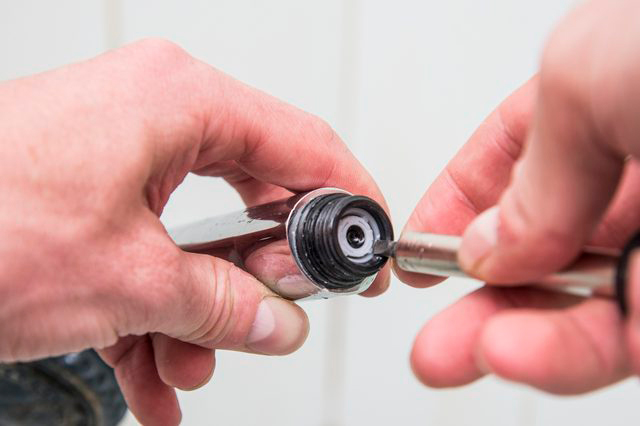If you’re like most people, you probably don’t give much thought to the water restrictor in your handheld shower head. But if you’ve ever found yourself struggling to get a good flow of water from your shower, or if your shower head seems to need constant adjusting to keep the water pressure up, then it’s worth considering removing the water restrictor.
Water restrictors are devices that are installed in shower heads to limit the amount of water flow. This is usually done for one of two reasons: to save water, or to reduce the risk of damage to the shower head from high water pressure.
In this article, we’ll show you how to remove a water restrictor from a handheld shower head. We’ll also discuss the benefits of doing this, and offer some tips for keeping your shower head functioning properly without the restrictor.
Here’s all you need to know.

Image Credit: https://www.waterfiltermag.com/
Removing A Water Restrictor From A Handheld Shower Head
If you’re not sure whether your shower head has a water restrictor, the easiest way to find out is to unscrew it and take a look. In most cases, the restrictor will be located near the base of the shower head, where the water enters.
Once you’ve located the restrictor, removing it is relatively simple. Use a small screwdriver or another sharp object to poke a hole in the center of the restrictor (this will release the water pressure), then unscrew it with your fingers.
If you have any trouble removing the restrictor, you may need to use pliers. Just be careful not to damage the showerhead in the process.
Benefits Of Removing A Water Restrictor From A Handheld Shower Head
There are several benefits to removing the water restrictor from your shower head.
The most obvious benefit is that you’ll get a better flow of water from your shower. This can be especially helpful if you live in an area with low water pressure, or if your shower head is located some distance from the main water supply. Increasing the water pressure in your shower can also help to improve the quality of your shower, making it feel more refreshing and invigorating.
Another benefit of removing the restrictor is that it will prolong the life of your shower head. Over time, minerals in the water can build up and clog the small holes in the restrictor, which can reduce the flow of water and put extra strain on the shower head. By removing the restrictor, you can help prevent this build-up and extend the life of your shower head.
Finally, removing the water restrictor can be a good way to troubleshoot problems with your shower head. If you’re having trouble with low water pressure or poor water flow, removing the restrictor may be all you need to do to fix the problem.
Tips For Keeping Your Handheld Shower Head Functioning Properly Without The Restrictor
If you decide to remove the water restrictor from your shower head, there are a few things you can do to keep it functioning properly:
- Use distilled or filtered water to clean it: This will help to prevent mineral build-up in the shower head and keep the water flowing freely.
- Avoid using too much water pressure: This can damage the shower head and cause leaks. If you live in an area with high water pressure, consider installing a pressure-reducing valve to help protect your shower head.
- Clean the shower head regularly: Use a soft cloth to wipe away any mineral deposits that may have built up on the shower head. You can also use vinegar or lemon juice to remove stubborn deposits.
- Inspect the shower head for leaks: Check the connections and seals on your shower head regularly to make sure there are no leaks. If you do find a leak, tighten the connection or replace the seal.
- Replace the shower head if necessary: If your shower head is more than five years old, it may be time to replace it. Over time, the seals and connections on a shower head can wear out, which can lead to leaks. Replacing an old shower head is a relatively simple and inexpensive task that can help keep your shower in good working condition.
By following these tips, you can help ensure that your handheld shower head continues to work properly without the water restrictor.
Adding A Handheld To An Existing Shower Head
In addition to removing a water restrictor, you may also want to add a handheld showerhead to your existing shower head. This can be a good way to increase the flexibility and functionality of your shower.
Adding a handheld showerhead is a relatively simple task that can be completed in just a few minutes. Most handheld showerheads come with all the necessary hardware and instructions. Simply remove your old shower head, then screw on the new one in its place. It’s that easy.
Once you’ve added your new handheld showerhead, you may want to consider removing the water restrictor (if there is one). As mentioned above, this can help to improve the flow of water from your shower and extend the life of your shower head.
Choosing The Best Handheld Shower Heads
If you choose one of the best handheld shower heads, removing the water restrictor might not be necessary. These showerheads are designed to provide a powerful flow of water, even with the restrictor in place.
When choosing a handheld shower head, look for one that is made of high-quality materials and has a good reputation. Avoid cheap, plastic models that are likely to break or leak after just a few uses. Instead, opt for a metal shower head with solid construction.
In addition, pay attention to the flow rate of the shower head. Most shower heads have a flow rate of 2.5 gallons per minute (GPM). However, some high-end models have a flow rate of up to 3 GPM. The higher the flow rate, the more water your shower head will be able to deliver.
Finally, make sure to choose a shower head that is compatible with your existing shower. Some shower heads are designed for use with certain types of showers (such as those with low water pressure). Others are not compatible with certain types of showers (such as those with high water pressure). By choosing a compatible shower head, you can help ensure that your new shower head will work properly and last for many years to come.

Image Credit: https://www.dcen.net/
Final Thoughts On How To Remove Water Restrictor In A Handheld Shower Head
In conclusion, removing the water restrictor from your handheld shower head can be a simple and effective way to improve the flow of water from your shower. If you do decide to remove the restrictor, be sure to follow the tips above to help keep your shower head in good working condition.
The post How To Remove Water Restrictor In A Handheld Shower Head appeared first on Kitchen Infinity.
kitcheninfinity.com










